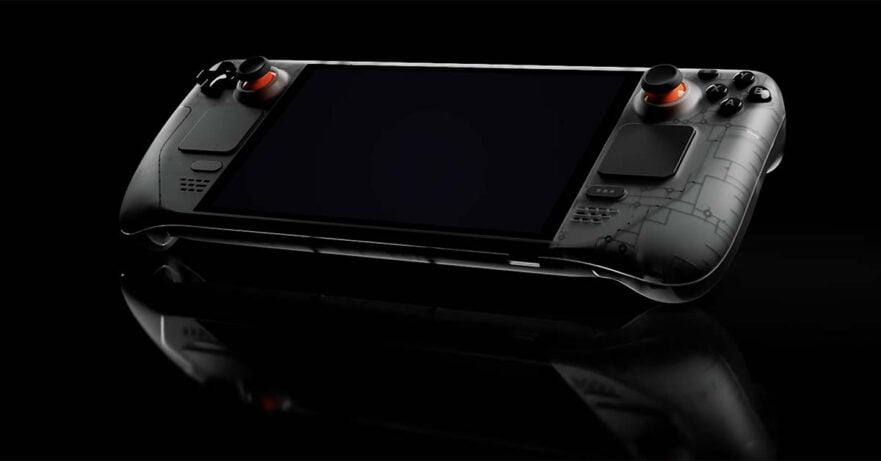Valve has quietly announced a new Steam Deck handheld gaming PC, offering a larger and better screen, up to 50% longer battery life, and refreshed internals, all for a higher asking price.
(Update, December 17: DataBlitz has announced the availability of the Steam Deck OLED in the Philippines!)
But to be clear, the Steam Deck OLED is not faster than the original that came out early last year. Besides the slightly bigger display, it also looks identical to the OG version, which is not surprising since it’s not meant to replace the old Steam Deck, with Valve apparently sticking with its plan not to launch a faster model for the next few years. If anything, this upgraded model is everything the first-gen Steam Deck should have been.
The Steam Deck OLED starts at $549, or roughly P30,722, in the U.S. for 512GB of NVMe storage, and starts shipping on November 16. If you need more storage space — and it’s probably a wise decision to opt for more memory for your games and media — the 1TB variant will be priced at $649 (P36,318). There’s also the option to purchase the Steam Deck OLED in a slick translucent red case for $679 (P37,996).
Introducing Steam Deck OLED. Featuring an HDR OLED screen, longer battery life, and faster downloads. Available November 16th.
— Steam Deck (@OnDeck) November 9, 2023
Learn more at https://t.co/uVdBCpJVuX pic.twitter.com/W4YnimTqCL
Official Steam Deck OLED introduction video
With the launch of the new model, Valve has permanently marked down all existing versions of the Steam Deck rocking a 60Hz LCD screen, and the company says it will continue to support the handheld. The 64GB storage variant, for example, drops to $349 or P19,530 (previously $399 or P22,328), while the 512GB unit that was $649 (P36,318) at launch now costs $449 (P25,126).
In case you’re interested, here’s a full breakdown of what’s new with the Steam Deck OLED courtesy of Valve’s official website:
- General
- Updated APU to 6 nm for better efficiency
- Updated memory to 6400 MT/s, improving latency and power management
- Increased thermal module thickness and performance
- Display
- Increased active area to 7.4″ (from 7.0″)
- Updated refresh rate to 90Hz (from 60Hz)
- Updated peak brightness to 1000 nits
- Updated touchscreen polling rate to 180Hz, improved latency and accuracy
- WiFi/Bluetooth:
- Updated WiFi/Bluetooth module
- Added support for WiFi 6E
- Added support for Bluetooth 5.3, supporting newer codecs such as aptX HD and aptX low-latency
- Added third antenna near the top of the device for better Bluetooth performance, including when docked
- Added support for wake from Bluetooth controllers
- Audio
- Improved bass response for an overall flatter sound profile
- Added support for using onboard microphone array simultaneously with the 3.5mm headphones connector
- Controls
- Adjusted analog stick top material and shape for increased grip and dust build-up resistance
- Adjusted analog stick post material to improve interaction feel with front cover and reduce wear
- Improved reliability of analog stick touch detection
- Improved responsiveness and tactility of shoulder buttons switch mechanism
- Adjusted D-pad snap ratio and diagonal interactions
- Redesigned trackpad for improved fidelity and edge detection
- Greatly improved trackpad haptics feel and precision
- Power
- Improved battery capacity from 40Wh to 50Wh
- Improved battery chemistry for faster charging, from 20% to 80% in as little as 45 minutes
- Changed charging LED to WRGB
- Added support for waking up from initial unboxing by long-pressing power button instead of requiring AC power
- Adjusted power supply cable length from 1.5m to 2.5m
- Added logo to power supply
- Frame
- Reduced total system weight to ~640g, or ~5% less than Steam Deck
- Rear cover screws now thread into metal
- Adjusted rear cover screw heads to Torx, as well as other materials and geometry tweaks on the heads to reduce stripping risk
- Lowered number of screw types throughout system
- Reduced step count required for common repairs
- Improved bumper switch mechanism drop reliability
- Moved bumper switch to joystick board for easier repair
- Improved display repair/replacement to not require taking rear cover off
- Software
- Greatly improved memory power management firmware
- Added preliminary support for open-source BIOS and EC firmware
- Improved resume time by roughly 30%
Share this Post


